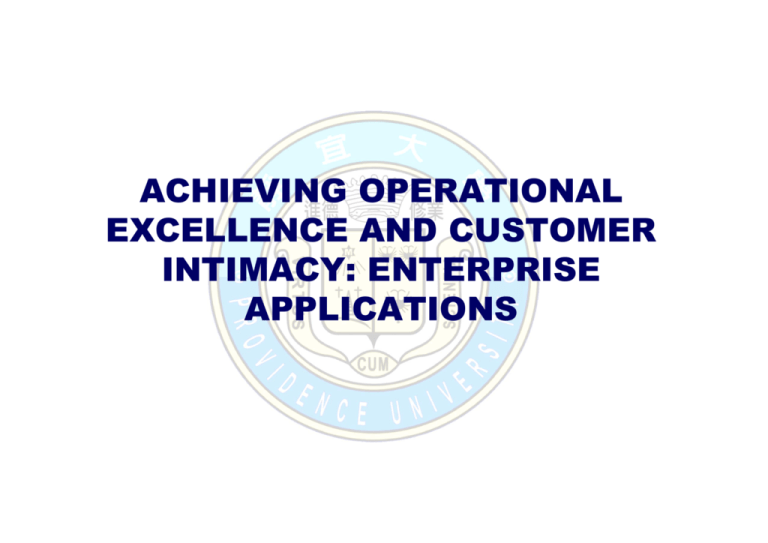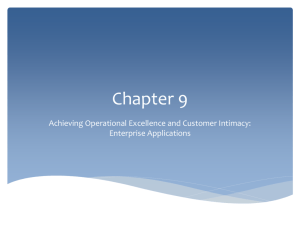Enterprise Systems
advertisement

ACHIEVING OPERATIONAL EXCELLENCE AND CUSTOMER INTIMACY: ENTERPRISE APPLICATIONS IM (Spring 2015) Content • How do enterprise systems help businesses achieve operational excellence? • How do supply chain management systems coordinate planning, production, and logistics with suppliers? • How do customer relationship management systems help firms achieve customer intimacy? • What are the challenges posed by enterprise applications? • How are enterprise applications used in platforms for new cross-functional services? 2 IM (Spring 2015) Enterprise Systems • Also called “enterprise resource planning (ERP) systems” • Suite of integrated software modules and a common central database • Collects data from many divisions of firm for use in nearly all of firm’s internal business activities • Information entered in one process is immediately available for other processes 3 IM (Spring 2015) Enterprise Software • Built around thousands of predefined business processes that reflect best practices – Finance/accounting: General ledger, accounts payable, etc. – Human resources: Personnel administration, payroll, etc. – Manufacturing/production: Purchasing, shipping, etc. – Sales/marketing: Order processing, billing, sales planning, etc. • To implement, firms: – Select functions of system they wish to use – Map business processes to software processes • Use software’s configuration tables for customizing 4 IM (Spring 2015) HOWENTERPRISESYSTEMSWORK 5 IM (Spring 2015) Business value of enterprise systems • Increase operational efficiency • Provide firm wide information to support decision making • Enable rapid responses to customer requests for information or products • Include analytical tools to evaluate overall organizational performance 6 IM (Spring 2015) Supply Chain Management Systems • Supply chain: – Network of organizations and processes for: • Procuring raw materials • Transforming them into products • Distributing the products • Upstream supply chain: – Firm’s suppliers, suppliers’ suppliers, processes for managing relationships with them • Downstream supply chain: – Organizations and processes responsible for delivering products to customers 7 IM (Spring 2015) NIKE’SSUPPLYCHAIN 8 IM (Spring 2015) Information and supply chain management • Inefficiencies cut into a company’s operating costs – Can waste up to 25% of operating expenses • Just‐in‐time strategy: – Components arrive as they are needed – Finished goods shipped after leaving assembly line • Safety stock – Buffer for lack of flexibility in supply chain • Bullwhip effect – Information about product demand gets distorted as it passes from one entity to next across supply chain 9 IM (Spring 2015) THEBULLWHIPEFFECT 10 IM (Spring 2015) Supply chain management software • Supply chain planning systems – – – – – Model existing supply chain Demand planning Optimize sourcing, manufacturing plans Establish inventory levels Identifying transportation modes • Supply chain execution systems – Manage flow of products through distribution centers and warehouses 11 IM (Spring 2015) Global supply chain issues • Global supply chain issues – Global supply chains typically span greater geographic distances and time differences – More complex pricing issues (local taxes, transportation, etc.) – Foreign government regulations • Internet helps companies manage many aspects of global supply chains – Sourcing, transportation, communications, international finance 12 IM (Spring 2015) Supply chain management systems • Push‐based model (build‐to‐stock) – Schedules based on best guesses of demand • Pull‐based model (demand‐driven) – Customer orders trigger events in supply chain • Sequential supply chains – Information and materials flow sequentially from company to company • Concurrent supply chains – Information flows in many directions simultaneously among members of a supply chain network 13 IM (Spring 2015) THE BULLWHIP EFFECT 14 IM (Spring 2015) Business value of SCM systems • • • • • • Match supply to demand Reduce inventory levels Improve delivery service Speed product time to market Use assets more effectively Reduced supply chain costs lead to increased profitability • Increased sales 15 IM (Spring 2015) THEFUTUREINTERNET‐DRIVENSUPPLYCHAIN 16 IM (Spring 2015) Customer relationship management (CRM) systems • Knowing the customer – In large businesses, too many customers and too many ways customers interact with firm • Customer relationship management (CRM) systems – Capture and integrate customer data from all over the organization – Consolidate and analyze customer data – Distribute customer information to various systems and customer touch points across enterprise – Provide single enterprise view of customers 17 IM (Spring 2015) CustomerRelationshipManagementSystems 18 IM (Spring 2015) CRM software • CRM packages range from niche tools to large‐ scale enterprise applications • More comprehensive have modules for: – Partner relationship management (PRM) • Integrating lead generation, pricing, promotions, order configurations, and availability • Tools to assess partners’ performances – Employee relationship management (ERM) • E.g. Setting objectives, employee performance management, performance‐based compensation, employee training 19 IM (Spring 2015) CRM packages tools • Sales force automation (SFA) – E.g. sales prospect and contact information, and sales quote generation capabilities • Customer service – E.g. assigning and managing customer service requests; Web‐based self‐service capabilities • Marketing – E.g. capturing prospect and customer data, scheduling and tracking direct‐marketing mailings or e‐mail 20 IM (Spring 2015) HOWCRMSYSTEMSSUPPORTMARKETING 21 IM (Spring 2015) CRMSOFTWARECAPABILITIES 22 IM (Spring 2015) CUSTOMERLOYALTYMANAGEMENTPROCESSMAP 23 IM (Spring 2015) CRM • Operational CRM: – Customer‐facing applications • E.g. sales force automation, call center and customer service support, and marketing automation • Analytical CRM: – Analyze customer data output from operational CRM applications – Based on data warehouses populated by operational CRM systems and customer touch points • Customer lifetime value (CLTV) 24 IM (Spring 2015) ANALYTICALCRMDATAWAREHOUSE 25 IM (Spring 2015) Business value of CRM • • • • • • Increased customer satisfaction Reduced direct‐marketing costs More effective marketing Lower costs for customer acquisition/retention Increased sales revenue Reduce churn rate – Number of customers who stop using or purchasing products or services from a company. – Indicator of growth or decline of firm’s customer base 26 IM (Spring 2015) Enterprise Applications: New Opportunities and Challenges • Highly expensive to purchase and implement – $3.5 million to over $12 million • • • • Technological changes Business process changes Organizational changes Switching costs, dependence on software vendors • Data standardization, management, cleansing 27 IM (Spring 2015) Next-generation enterprise applications • Move is to make applications more flexible, Web‐enabled, integrated with other systems • Enterprise suites – Software to enable CRM, SCM, and enterprise systems work together and with suppliers and client systems – Utilize Web services, SOA • Open source & on‐demand solutions • Mobile compatible; Web 2.0 capabilities • Complementary analytics products 28 IM (Spring 2015) Service platform • Integrates multiple applications to deliver a seamless experience for all parties – E.g. Order‐to‐cash process • Portal software – Used to integrate information from enterprise applications and legacy systems and present it as if coming from a single source 29 IM (Spring 2015) ORDER‐TO‐CASHSERVICE 30









